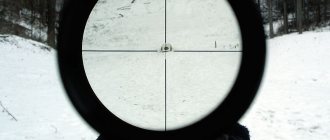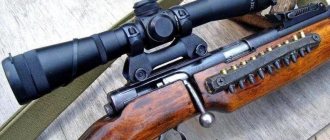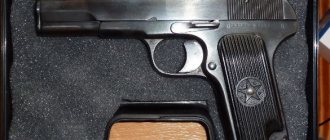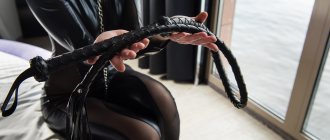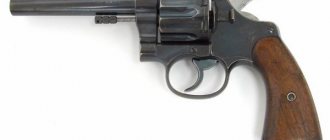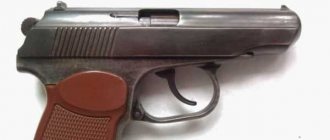Home / Support / Installing and zeroing optics /Zooming an optical sight
Correctly adjusting the optical sight will allow you to shoot truly “sightedly”, accurately, quickly and without danger to others. And this applies to any weapon, that is, for example, zeroing an optical sight on an air rifle is also necessary.
Types and characteristics of sights
The optical sight is adjusted taking into account its key, basic characteristics:
- magnification (magnification size) – constant or variable (in pancratic sights it is forced to change from 1.5 to 9 or more), the first option is significantly cheaper, but the second is more universal;
- field of view - the space visible through the sight;
- sighting reticle - a special marking image that has an optical sight;
- lenses – the brightness and contrast of the picture depend on their quality; lens sizes affect the weight and dimensions of the device;
How to make a parallax background?
The first way is to create a file, for example script. js, add the code to it, and then connect it immediately after the library from the previous step. The second way is to wrap it in tags and also add it after the library. The third line of code specifies that all blocks with data-type=" background
» the parallax effect will be applied.
Interesting materials:
What should be applied to the nail before the base? What should you apply to your nails before gel polish? What should you wear this fall? What should you wear with an apple figure? What needs to be laid under a frame pool? What should you put in your emergency backpack? What should you take for prostatitis? What should you take if you have an inflamed gallbladder? What do you need to purchase for a hardware manicure? What should a man check after 40 years of age?
What is parallax?
Parallax is described in the documents for every optical sight. This is the displacement of the target relative to the eye - at a distance the reticle will not always be strictly on the target.
The effect usually manifests itself at distances of over a hundred meters, and errors of five or more centimeters appear even at half a kilometer. Therefore, in field conditions, parallax will not hurt.
Moreover, almost all optics initially have a parallax adjustment of one hundred meters. This is enough for, for example, subsequent adjustment of an optical sight for a carbine to be successful.
Reliability
“The VX-1 series scopes are not as durable as the VX-2 series scopes.”
- All Leupold scopes come with an unlimited lifetime warranty. All of them are designed to withstand the toughest loads imaginable.
- To ensure that the lifetime warranty is not just an empty phrase, each scope model is tested for resistance to shock and recoil.
- In terms of reliability, all series are equivalent - VX-1, VX-2, VX-3, etc.
- Rigorous testing (torture) of Leupold scopes.
Preparatory stage
Zeroing an optical sight does not mean mindlessly shooting at targets. First you will need to carry out preparatory work:
- adjust the sharpness of the aiming reticle to maximum (see the instructions for the device); sharpness seems to be greater if you look through the scope for a long time, so it’s better to adjust the parameter right away or take breaks; a low-contrast background, such as the sky, is suitable;
- determine the distance - one hundred meters is considered universal (for example, this is how an optical sight for a carbine is adjusted), zeroing an optical sight on small guns and smooth-bore weapons is carried out at a distance of fifty meters;
- prepare a target - at least 0.5 by 0.5 meters; no traces of previous shots, all images are clear and visible;
- In order for the adjustment of an optical sight for an air rifle or any other long-barreled weapon to be successful, it is better to secure the weapon motionless in a sighting machine, place it on a bipod or support; This way you will be able to cope with image shaking, which is especially noticeable when shooting at maximum magnification.
Zeroing pneumatics with an optical sight is done in the same way.
At the same time, flat or round bullets are more suitable for zeroing - they give an even hole.
Optical sight selection
The history of optical sights begins with the invention of the telescope.
During the American Civil War in the 1860s, references to the use of firearms with the first analogues of optical sights by a rifle-sniper squad surface.
Year after year, the scientific community received patent applications for increasingly advanced optics. The birth of the modern optical sight has begun. An accurate shot or how to choose an optical sight?
In this section we will look at the properties of optical sights. The first question you need to ask yourself is what is the scope for? What will be the scope of its application?
In general, we distinguish four main categories:
| Tactical/precision sights | Pneumatics | Crossbows | Firearms |
| -Have the ability to manually adjust the adjustment drums -Presence of parallax adjustment -Lens diameter of at least 50 mm = high aperture ratio - Multiplicity : average value x10-12 - Lens coating - Ballistic sighting reticle It is desirable to have a backlight (the reticle lines are more contrasting). Nikon Monarch 5 5-25X50ED SF with an improved Advanced BDC reticle is perfect for this category | —Resistance to double multidirectional return -Firing distances: 20-50 meters, magnification x1.5-6, 70-100 meters magnification x9-12 —Secure fastening , for a more stable sight position. An excellent option for pneumatic rifle scope Veber 4-16x40 AOE RG MD . | -Sight magnification : constant up to x4 and variable x3-9, x4-10 - Specific sighting reticle to quickly make adjustments (convenient scale for calculating distances, auxiliary crosshairs). A good option with an optimal reticle is the Bushnell Green 3-9×40 np sight . | - Lens diameter : take into account the time of day at which the sight will be used. The optimal diameter is 40 mm during the day, 50-55 mm at dusk or night - The magnification depends on the type of hunting and the shooting range acceptable for this hunt.* See the table below. Nuances: • An increase in the magnification entails a narrowing of the field of view. • Accurate shooting at high magnification requires a rest/bipod. For hunting with firearms, a line of sights that can withstand the recoil of large calibers is suitable. Yukon Jaeger |
It is worth noting that the choice of optical sights is huge; there is no clear distinction that this or that model is suitable only for pneumatics or only for firearms; focusing on the parameters, you can definitely choose the right option for yourself.
Let's look at each of the main properties of optical sights.
Multiplicity
- Sights with constant
magnification have greater aperture due to their unloaded design. The result is a clearer image.
Application:
if it is known exactly in what conditions and at what shooting distances they will be used.
- Variable magnification (pancratic) sights
produce a darker image. The design of these sights is more complex. A large number of lenses absorb light. An important parameter when choosing a scope will be light transmittance. Due to the large magnification range, they are universal.
Application:
changing the magnification allows you to select the optimal magnification and the required field of view. Do not forget that magnifying an object allows you to see better, but not better to shoot.
line of sight
The maximum horizontal linear distance that can be seen through the scope at a distance of 100 m.
A larger field of view
makes it easier to
find and lock on a target
.
- The angle that determines the field of view is inversely proportional to the magnification: the higher the magnification, the smaller the field of view.
- The field of view is independent of the lens diameter. A large lens increases aperture, but does not expand the field of view.
Exit pupil
The larger the exit pupil, the brighter the image will be
, delivered by an optical instrument to your eye.
It is a reduced image of the lens presented through the eyepiece. A small circle of light visible through the eyepiece lens (sight at arm's length). The larger the diameter of the exit pupil, the brighter the image visible to the eye through the device.
Calculations:
If you want to know the exit pupil size of your scope, divide the diameter of the objective lenses in mm by its magnification. For example, (36 mm) : (x4) = 9 mm is the exit pupil size.
Eye relief
The optimal distance of your eye from the eyepiece lens to obtain the clearest picture. Also called working distance from the eye.
The maximum distance at the moment is 13 cm; for most sights, the eye relief is between 7 and 10 cm. It is important when working with a high-recoil gun to choose sights with a large working distance from the eye.
Lens
Represents
a system of two or more lenses. The larger the diameter of the lens, the more light it collects and provides greater aperture and a brighter image.
In the World of Hunting store catalog you can find a scope with the smallest lens diameter RTI 4x15 Mitron
, and with the largest
Zeiss 6-24×72 Diavari
.
Parallax adjustment
Parallax is the apparent displacement of the reticle relative to the aiming point at different distances.
Parallax is most noticeable when the shooter's eye moves away from the center of the scope lens when observing a target located at a distance different from the scope's factory parallax adjustment distance.
| AO — the parallax adjustment ring is located on the sight lens in the form of a wide ring. An example of sights with AO in the World of Hunting catalog . | |
| SF – the parallax adjustment mechanism in the form of a drum is located on the side of the control unit. our catalog for sights with a parallax adjustment mechanism in the form of drums . |
Sights with parallax adjustment are designed for shooting at long and ultra-long distances, when the accuracy of the shot is affected by every millimeter of parallax adjustment, corrections for wind, pressure, temperature and other environmental features.
Reticle
It is either a metal stencil made of thin wire, or glass with an applied
with a pattern
on it (less susceptible to confusion).
The placement of the reticle is either in the first focal plane - located in the middle of the sight, the image in it is inverted, or in the second - located in the eyepiece area, the image is upright.
There are different variations of reticles
convenient for certain situations.
The aiming mark
can have any shape: dot, circle, cross, etc.
Horizontal and vertical lines marked on the reticle help the shooter to optimally align the weapon while avoiding deviations from the target.
Also, auxiliary aiming marks can be applied to the reticle, used to adjust the ballistics of the bullet at different distances.
Reticle illumination
significantly expands the light range of use of the sight and allows you to aim in the twilight.
Ballistic correction system
Necessary for adjusting the trajectory of a bullet to a certain distance. This system allows you to quickly and accurately adjust the aiming mark in accordance with the distance to the target.
Amendment price
Measured in minutes of arc (MOA)
, represents the price of dividing the correction mechanism on the drums. Rotating the cylinder one click corresponds to a change in point of impact, such as 1/4 inch at 100 yards.
The further away your goal is, the lower the division price should be. For short-range shooting, it is advisable to choose a division value of 1 MOA or 2 MOA.
Protection from external influences
Impact resistance
sight is one of the key parameters for medium and high power carbines. The impact caused by the recoil of large calibers loosens the adjustment and fastening elements of optical systems. When choosing a scope, you should pay attention to recoil resistance for its long service life.
Tightness
The sight is an important parameter for working “in the field”. When hunting outdoors, no one is safe from rain, wet snow, or temperature changes. A scope that can withstand the elements will last you much longer.
Nitrogen filling
The sight serves as additional protection against lens fogging.
It’s quite difficult to navigate when choosing a sight with all the variety of parameters. You need to understand exactly for what purpose you need it.
.
Selection of optical sights
presented in our catalog
of the World of Hunting store
.
The reference article is based on the expert opinion of the author
Shooting
First, the optical sight is cold zeroed. It is necessary to look at the target through the bore, then a crosshair is displayed on it using adjustments.
Laser sighting is done using a special target designator. The shooter places the laser in the chamber (loads it like a cartridge) and points it at the target. The reticle is then adjusted so that its center aligns with the pointer. The procedure is correct up to one hundred meters.
Afterwards, you need to shoot at one point several times without adjusting the sight, this is how the average point of impact is determined (the intersection of conditional lines drawn from all the resulting holes).
If the distance between the outer holes is no greater than specified for the weapon (up to five centimeters per hundred meters), do not worry. Otherwise, we can talk about a malfunction or interference during the shot.
Precautionary measures
Now a few words about what safety rules the shooter must follow when zeroing the optics. After all, cases where someone was injured or killed while working with optics are not uncommon. Here are just the basic precautions that must be observed:
- Shooting location. It is strictly forbidden to zero in optics in places where there is a chance of people appearing. If you live in the city, then you should go to a shooting range or go outside the populated area into a field or forest. In this case, it is worth choosing a place where there will be a minimum of vegetation that blocks the view. You should also remember that curious individuals may come to the sound of gunfire, so you should be vigilant.
- Cartridges and fuse. Let's start with the fact that during preparatory work and cold zeroing, the rifle should under no circumstances be loaded with cartridges (the magazine should be disconnected and the bolt put on hold). It is necessary to remove the weapon from the safety only immediately before firing. Also, don’t forget to put your rifle in safe mode before heading to the target.
Shooting requires increased vigilance
- Individual protection means. It is strongly recommended to use safety glasses and headphones when shooting (especially at short distances). This will protect the visual organ from recoil, and the auditory organ from deafening. Also, do not forget that the bullet can ricochet or even cause the barrel to rupture. It is impossible to foresee all situations, but glasses and headphones will protect you at least a little.
- Do not trust your rifle into the wrong hands. Remember that only you know the condition of your weapon. If a shooter, God forbid, forgets to put the rifle on safety and goes into the line of fire, and his comrade wants to “play a joke,” this could end badly. To avoid such situations, declare a strict ban on the use of your rifle if the shooting is carried out in a company.
- Pre-cleaning and lubrication. It often happens that after purchasing optics, a hunter immediately takes out a rifle from the safe, which has not seen service for a long time, installs a “body kit” on it and starts shooting. Well, shooting from a barrel that is full of lead coating sooner or later leads to a rupture of the channel. To prevent this from happening, be sure to clean and lubricate the rifle before zeroing.
- Don't forget to remove the laser after cold zeroing. Quite often, hunters leave a target designator in the chamber, designed to adjust the optics, and start shooting with live ammunition. This may result in the destruction of an expensive device. So before you move from cold to hot zeroing, first make sure that there is nothing left in the barrel channel.
- Ammunition. Use only ammo that matches your brand of weapon. Many Russian hunters neglect this rule, preferring to equip their carbine with cheap “roll-your-own” guns. Such a cartridge several times increases the likelihood that the barrel channel will rupture. Professionals recommend using only those ammunition that are specified in the instruction manual.
There is no shame in asking for help from professionals. Zeroing optics can be quite a challenging task for a novice hunter. It is not always possible to figure out how to install the body kit and how the drums work the first time. Well, in the shooting ranges this is not only explained in detail, but also shown in practice. So, if you wish, you can always go to a specialized establishment, where experts will adjust your optics with maximum precision.
Correctly zeroing an optical sight is an important step in setting up a hunting rifle. A rifle without a body kit will not be able to reveal its full potential, and a hunter with such a weapon is unlikely to be able to shoot anything worthwhile. However, once you understand this procedure, it will not cause difficulties in the future, and the weapon will be guaranteed to hit the target.

